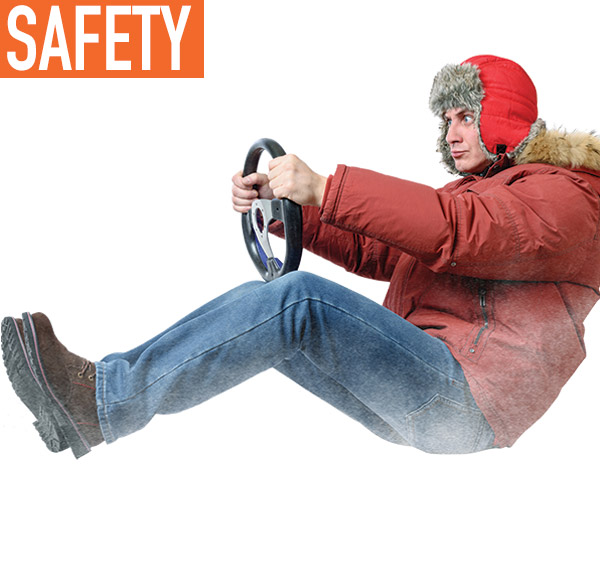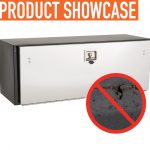As you’ve no doubt already experienced, winter inevitably brings with it challenging driving conditions. Snow and ice litter roadways, creating obstacles and causing unpredictable vehicle response. Slippery conditions are difficult to avoid and preparation for driving during this time of year is essential. You can ensure your safety with conservative driving, adequate maintenance, and the use of quality brakes that are appropriate for your vehicle and application. Choosing the right brakes for your vehicle will improve your vehicle’s performance in winter months and keep you safe on treacherous roads.
ICE, SNOW, AND SKIDDING
Everyone dreads driving on icy winter roads. The decreased traction between your tires and the road can dramatically increase the braking distance of your vehicle. When applying the brakes in icy conditions, steering problems can also occur. Understanding how your vehicle reacts to steering while skidding can prepare you for emergency maneuvers and reduce the likelihood of skids resulting in crashes.
It is also important to know your braking system. Many people react to sudden obstacles by pressing hard and quick on the brakes. If you do not have anti-lock brakes, this is dangerous and can cause your brakes to lock. When driving over ice, this will cause unpredictable skidding.
Another winter weather factor to consider is dealing with the effects of road salt. The addition of salt makes the road safer, but can cause corrosion of various braking components, including the rotor surfaces of the brake and the anti-lock braking system (ABS). This means that it is essential to properly maintain your vehicle’s brakes and ABS components, and to use quality replacement parts when repairs are necessary.
WINTER MAINTENANCE
There are many maintenance preparations you can make to your vehicle for icy conditions. Check the service schedule in your owner’s manual and consider scheduling a comprehensive maintenance check-up. A thorough check-up should evaluate your braking system, as well as tires, tire pressure, oil, lights, exhaust system, and ignition system.
It is also essential to make sure the heat and defrost systems work properly. Heating keeps certain vehicle components from freezing and malfunctioning. In the case of defrost systems: when frost or fogging occurs on moving vehicles it causes decreased visibility.
In addition, taking the time to check and replace windshield wipers and windshield fluid levels can make a tremendous difference in safely making your way through severe weather conditions. Clearing gathered snow from the hood and roof of your vehicle will prevent it from flying or falling onto your windshield or the windshields of other vehicles while driving. In some states, it is even illegal to neglect doing so.
Finally, cold weather can drain car batteries faster than in mild weather. A vehicle battery loses 35 percent of its strength at 32 degrees Fahrenheit and up to 60 percent at 0 degrees Fahrenheit.
During cold temperatures, starting an engine can take up as much as twice the current needed during summer conditions. Checking the status of your vehicle’s battery may help avoid issues with starting up on particularly cold days.
RECOMMENDATIONS
Bendix Brakes suggests that while checking your braking system, your technician should not only check brakes for wear, but also should check ABS components to ensure the anti-lock braking system is operating properly and the ABS sensors are clear of any corrosion or road salt.
If your brakes require replacing, look for brake rotors that are resistant to corrosion to reduce this occurrence in the future. Bendix premium brake rotors come with a special silver-aluminum-zinc-based corrosive protective coating that resists road salt and moisture. This coating also extends the life of the rotors and ensures a rust-free rotor contact surface for the brake pads by providing free-flow heat venting of the rotor.

While the lifespan of brake pads varies considerably based upon typical traffic and driving style, the average replacement interval for this component is 40,000 to 50,000 miles. When it is time to replace brake pads, look for pads that do not contain copper, which can pollute nearby water sources as the pads wear down and disintegrate.
By 2025, all brake manufacturers in the US must eliminate copper from their friction formulations following the California and Washington Proposition 65 regulations. Satisfying this regulation, as well as general environmental and expense concerns, Bendix has created premium copper-free brake pads with superior stopping power under all road conditions.
STAY SAFE
Careful driving and timely maintenance of your vehicle will make all the difference during colder weather, as precipitation makes things slippery. This includes making an investment in reliable brake system components. Top-quality braking systems last longer, require less maintenance, and can ensure your vehicle handles difficult conditions safely. Challenging road conditions are to be expected during the winter, but the right preparation will ensure you make your way to every destination safely—no matter the weather.
ABOUT THE AUTHOR:
Jim Hein is the sales executive at Bendix® Brakes. Find out more about Bendix Brakes products and services, visit www.bendix-brakes.com.
_______________________________________________________________________
MODERN WORKTRUCK SOLUTIONS: FEBRUARY 2017 ISSUE
Did you enjoy this article?
Subscribe to the FREE Digital Edition of Modern WorkTruck Solutions magazine.
![]()




